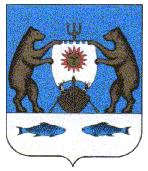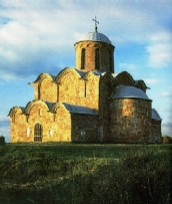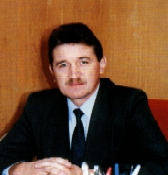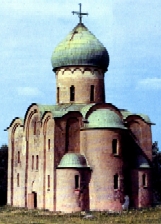|
NOVGOROD
RAYON (DISTRICT). DESCRIPTION
Shortcuts:
Introduction
Location
Historical Background
Population and Demographic Situation
Novgorod Rayon Today
Local Government System
Education and Culture
|
Introduction
Year of establishment: 1927
Telephone code: 81622
Time zone: Moscow time
|

|
<top>
Location
Novgorod rayon as a part of Novgorod Oblast is located in the Northwest
of Russia, and has an extremely favourable geographical position
on all major transportation throughways.
Automobile, air, water and rail highways connecting St.Petersburg
and Moscow cross through its territory. This is an important advantage
for those who plan to do business in the two Russia's most important
markets and who want easy communications with western regions of
Russia, Belarus, Baltic countries and the West.
It is the biggest rayon in the Northwest group, covers a territory
of 4.6 square kilometers and has a population of 55.4 thousand people.
Novgorod Rayon has a developed network of roads of both republican
and local significance with capacity 11 thousand cars per day. The
extension of roads of federal significance is 555 km, including
345 roads with hard cover. Two gas pipelines of high pressure are
covering the rayon's territory.
Density of population is 12 people for one sq.km. The working population
is 62% of the total population.
The rayon also has significant reserves of sand and gravel deposits
(30), including fusible clay deposits (3), and peat (10). Currently
the works had been undertaken to explore the mineralized chloride
sodium underground water for disinfection of water in accordance
with the Antichlor program.
223.7 thousand acres of land in the rayon are covered with forests
of predominately, deciduous trees (68%). Total timber yield is 40175
thousand cubic meters, including 17274 thousand cubic meters of
mature and overmature wood.
There is a variety of lakes in Novgorod Rayon (the biggest navigable
lake is Ilmen), and rivers Volkov, Msta and Vishera.
Novgorod Rayon lies in the moderate continental climatic zone and
has 4 distinct seasons, January being the coldest month and July
the warmest month. Average rainfall during warm season is 80mm and
the average snowfall is 30mm. Average annual temperature is +3°C:
in summer +18°C, in winter - 8°C.
By the average temperature in July - up to 20°C - the Novgorod
Rayon resembles many countries of Europe and of North America. Ottawa,
Winnipeg, Seattle are close to this temperature belt. By the annual
amount of precipitation Novgorod district concedes to many territories
of England, France and Switzerland. Though, spring, autumn and even
summer in the region happen to be rainy, so it makes sense to take
an umbrella with you.
Summer usually is not hot, the season "of white nights"
begins in May.
<top>
Historical Background
Traditionally the history of Novgorod rayon just like
other rayons is considered to begin in August 1972, the date when
the decree of All-Union Central Executive Committee of RSFSR approved
the final administrative and territorial division of Northwest Oblast,
which included Novgorod province. But the idea of such division
was suggested before the revolution. Actually the Rayon continued
the history of Novgorod Uyezd that was established in XVI century.
Suburbs of Novgorod had been marked out as Novgorod okrug (district)
more than a thousand years ago. More that a dozen of buried treasures
had been found here containing coins of Eastern origin of IX-X centuries,
a unique bronze ring of VIII century and iron articles of VIII IX
centuries.
|
Novgorod, having managed to avoid devastation
during the days of the Mongol invasion, preserved the greatest
spiritual and artistic values claimed by Russian culture during
the period of its new rise in 14th -15th centuries. They include
Church of Our Saviour Transfiguration on Nereditsa (1198) -
the architectural 'pearl' - the synthesis of architecture with
the surrounding nature, Church of the Saviour on Khoutyn (1192),
Church of Nikola on Lipna (1292) one of the first churches constructed
in Russia after Baty invasion, Church of Assumption (1352),
Church of the Saviour Transfiguration on Kovalev (1345), Our
Lady Vladimir Cathedral (1554), St. Nicholas Cathedral of the
Vyazhishchi monastery (1685). |
 |
Oneg estate where great Russian composer Rakhmaninov spent several
years is another remarkable place of Novgorod rayon.
Villages of the Novgorod rayon were filled with wooden houses.
Not for nothing did men of Novgorod have a reputation as carpenters
and wood-workers in the old days. Not only did they use wood to
make basins, pails, spoons, and combs, but also to build the boyar
palaces, houses and churches. Many of these wooded constructions
have been carefully collected and preserved in the Vitoslavlitsy,
the open-air museum of Novgorod wooden architecture.
The history of the rayon is the history of villages and settlements.
The transportation through Msta river by Bronnitsa village had been
put under control of the Antoniev monastery by Alexander Nevsky
and later by Dmitry Donskoy. The elite guards of Ivan III and Ivan
the Terrible were stationed at that village. At the beginning of
XVII century a desperate struggle with Swedes took place by Msta
river. Ekaterina II visited the Bronnitsa Hill on her way back to
Moscow. Vvedensky church with side-chapel of martyr Ekaterina was
constructed there to commemorate that event.
Arakcheev cadet school was stationed at the Novoselitsi village.
In 1501 Rakomo village was acknowledged to be the Czar's place and
unlike all other villages having only a few houses, it had 47 houses.
In 1824 a famous "Blue Bridge" was constructed across
Volhovets river, its wooden parts were painted blue. During the
war the bridge had been destroyed, after that it was rebuilt but
the name kept being the same. Siversov and Visherky channels were
built connecting Msta and Volkhov rivers.
Novgorod uyezd (district) was detached in the XVII century and
included almost a half of the modern oblast territory. Since 1708
Novgorod uyezd had been changing its territory for several times
and in 1773 it was broken up into other smaller uyezds. In 1802
the size of the uyezd stabilized for more than a century.
In 1930 Novgorod okrug (district) was abolished and until 1944 Novgorod
remained the district center of Leningrad oblast.
In August 1941 the city was seized by German forces and occupied
for two and a half years. Novgorod was near the front line all that
time and suffered much damages. There are a dozen of war memorials
in Myasnoy Bor, Savino and Volotovo to commemorate the courage of
killed Russian soldiers.
<top>
Population
and Demographic Situation
Population of Novgorod Rayon is 56.3 thousand people
and for the last decade it has undergone little changes. The natural
growth is characterized by negative parameters.
The working population is 33,1 thousand people; 22.7 thousand people
live in urban sections of the rayon and 10.5 thousand people live
in the cities. 17.4 thousand people are employed in national economy,
including 14.2 thousand people working at the industry.
Employed population is 13.1 thousand people.
In 2001 the number of officially unemployed people was 227, the
level of unemployment is 0.7% of working population.
The labour market in the rayon is influenced by the state of agriculture
and industry. The professional structure of the unemployed is the
following: drivers, mechanics, salesmen, electricians, seamstresses,
plasterers, accountants, engineers, and economists.
Located far from "hot spots" and with a near-homogenous
population (96% Russian), Novgorod Rayon is not troubled by national
and ethnic conflicts.
<top>
Novgorod Rayon
Today
Novgorod Rayon has a status of independent municipal
institution.
It consists of four villages: Pankovka, Proletary, Tesovsky, Tesovo-Netylsky
and 23 rural districts: Borkovsky (village Borki), Bronnitsky (village
Bronnitsy), Volotovsky (Volhovets village), Gostetsky (Gostsy village),
Grigorovky (Grigorovo village), Dubrovsky (Dubrovka village), Zakharinsky
(Zakharino village), Ermolinsky (Ermolino village), Ilmensky (Ilmen
village), Krasnostansky (Kranie Stanki village), Lesnovsky (Lesnaya
village), Novoselitsky (Novoselitsi village), Podberezsky (Podberezie
village), Rakomsky (Rakomo village), Savinsky (Savino village),
Selogorsky (Selo Gora village), Sergovsky (Sergovo village), Syrkovsky
(Syrkovo village), Trubichincky (Trubichino village), Finevsky (Finev
Lug village), Kholynsky (Kholynya village), Chastovsky (Chastova
village), Chechulinsky (Chechulino village).
Nowadays the look of the rayon had undergone significant changes.
A dozen of villages and settlements are decorated by modern solid
houses of the rich middle-high class people. Probably these changes
will facilitate other positive changes in other spheres of life.
Today Novgorod rayon means a quarter of all farm products produced
in oblast and the seventh part of all rural population.
Villages Pankovka, Proletary, Tesovsky and Tesovo-Netylsky are
famous by their enterprises. They produce construction materials,
chinaware, peat, flour and many other products; the same goes to
other districts and settlements like Podberezie. The industrial
potential of the rayon is rather high.
There are 845 companies and enterprises in Novgorod rayon, among
which 41 companies are involved in external economic activity. Additionally
there are 1568 private entrepreneurs and 169 farms in the rayon.
<top>
Government
System
The rayon government system is based on three traditionally
strong elements:
- Novgorod Rayon Council of Novgorod Oblast
- Novgorod Rayon Government
- Head of Rayon
The Head of Rayon is elected by the citizens every fifth year on
the base of equal and direct suffrage by secret vote in accordance
with the Federal Law "On the main guarantees of electoral rights
and the right to participate at the referendum of Russian citizens"
and Oblast Law "On election of the heads of municipal local
governments".
Rayon Council is a representative body of local self-government.
The Council consists of 10 deputies elected by the population for
the period of 5 years on the base of equal and direct suffrage by
secret vote in accordance with the Federal Law "On the main
guarantees of electoral rights and the right to participate at the
referendum of Russian citizens" and Oblast Law "On election
of the heads of municipal local governments".
Rayon administration is the administrative machinery, which carries
out assignments on behalf of the Head of Rayon. The Rayon administration
is empowered to establish its territorial and branch bodies of management,
like administrations of villages and rural districts, committees,
departments, and sections.
Contact Information
|
Head of Novgorod Rayon
Filippov Alexander Nikolaevich
78, Bolshaia Moskovskaia
173005 Velikii Novgorod, Russia
tel: 7(81622) 32288
|
 |
<top>
Education and
Culture
|
 |
Modern
Novgorod rayon is a stunning combination of old and new. One
of the largest monuments complexes of Russia, totaling over
30 monasteries and 120 monuments of culture and history had
been preserved in the rayon.
|
The well-developed connections of Novgorod, its central
position in a vast territory and the unique combination of princely
and democratic traditions in its social life… all these features
contributed to the creation of a unique phenomenon we now call "the
artistic culture of medieval Novgorod". All attributes of medieval
Christian culture -- stone architecture, monumental and easel painting,
applied arts and jewelry, the unique complex of Old Russian architecture
of the XI - XVII centuries - were developed to demonstrate magnificent
results.
Novgorod icon painting presents the greatest
school of Old Russian monumental painting. Moreover the school of
Novgorod architecture is the most significant in the history of
Russian architecture.
The following educational
institutions are situated in the rayon:
- 12 kindergartens
- 26 schools
- 3 high schools
- 11 infant schools
- 36 clubs
- 34 libraries
All educational
institutions are staffed with qualified teachers. For the last few
years five teachers had been conferred the honorary title "Honored
school teacher of Russia". 30% of school graduates graduate
from school with profession, 45% children start going to school
at the age of 6.
Since 1994 the leading medical institution of the rayon is Central
Rayon Medial Clinic, which occupies a new and modern building in
Trubichino. Additional medical services are provided by 3 hospitals,
medical assistant and obstetrical centers, 9 drugstores and 45 pharmaceutical
centers. There are 61 doctors and 245 medical personnel in the rayon.
In 1995 for the first time the rayon participated at the second
international Rachmaninov musical festival. 13 musical groups have
the title "National". "Lubava" choir took part
at the international festival of choral music in Malta. There is
an ethnographical museum in Navolok village which in 1993 was conferred
the honorary title "National".
It has become a tradition to organize folk and pop music festivals,
sport holidays and youth amateur art days.
All folk groups demonstrate their artistry and techniques at the
annual folklore and arts festival in Navolok village.
Since 1994 all villages of the rayon have been celebrating their
anniversaries. The musical schools organize and conduct contests
of young pianists, folk instruments' players, choirs, and others.
There are 11 social and cultural complexes established in the form
of legal entities.
<top>
|

